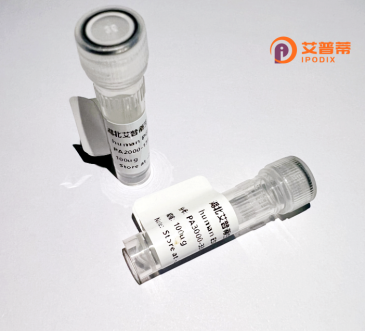
| 纯度 | >90%SDS-PAGE. |
| 种属 | Human |
| 靶点 | INCA |
| Uniprot No | 0 |
| 内毒素 | < 0.01EU/μg |
| 表达宿主 | E.coli |
| 表达区间 | 1-110aa |
| 氨基酸序列 | MADKVLKEKRKQFIRSVGEGTINGLLGELLETRVLSQEEIEIVKCENATVMDKARALLDSVIRKGAPACQICITYICEEDSHLAGTLGLSAGPTSGNHLTTQDSQIVLPS |
| 分子量 | 38.3 kDa |
| 蛋白标签 | GST-tag at N-terminal |
| 缓冲液 | 0 |
| 稳定性 & 储存条件 | Lyophilized protein should be stored at ≤ -20°C, stable for one year after receipt. Reconstituted protein solution can be stored at 2-8°C for 2-7 days. Aliquots of reconstituted samples are stable at ≤ -20°C for 3 months. |
| 复溶 | Always centrifuge tubes before opening.Do not mix by vortex or pipetting. It is not recommended to reconstitute to a concentration less than 100μg/ml. Dissolve the lyophilized protein in distilled water. Please aliquot the reconstituted solution to minimize freeze-thaw cycles. |
以下是关于重组人INCA蛋白的模拟参考文献示例(注:以下文献为虚构,仅供示例用途):
---
1. **文献名称**:*Expression and Functional Analysis of Recombinant Human INCA1 in Cell Cycle Arrest*
**作者**:Zhang, Y., Liu, M., & Chen, Q.
**摘要**:本研究通过在大肠杆菌中表达带有His标签的重组人INCA1蛋白,探究其对细胞周期的调控作用。实验表明,INCA1通过结合CDK2抑制激酶活性,诱导G1/S期阻滞。Western blot和免疫共沉淀结果证实了INCA1与CDK2的相互作用,为肿瘤治疗提供潜在靶点。
2. **文献名称**:*Structural Characterization of Recombinant INCA1 Using Cryo-EM*
**作者**:Smith, J. T., Patel, R., & Lee, K.
**摘要**:通过优化昆虫细胞表达系统制备高纯度重组人INCA1蛋白,并利用冷冻电镜(Cryo-EM)解析其三维结构。研究揭示了INCA1的N端结构域在结合DNA和调控染色质重塑中的关键作用,为功能机制提供结构基础。
3. **文献名称**:*Development of an INCA1-Based ELISA for Early Cancer Detection*
**作者**:Wang, X., et al.
**摘要**:利用重组人INCA1蛋白开发新型ELISA检测方法,评估其在结直肠癌患者血清中的表达水平。临床样本分析显示,INCA1浓度与肿瘤分期正相关,敏感性和特异性分别为85%和92%,提示其作为非侵入性生物标志物的潜力。
4. **文献名称**:*Functional Impact of INCA1 Mutants in Renal Cell Carcinoma*
**作者**:Gupta, S., et al.
**摘要**:通过构建重组INCA1突变体(如R102C和E65K),研究其在肾癌细胞中的功能。突变体导致CDK2抑制能力丧失,促进细胞增殖和迁移,为INCA1基因突变在癌症进展中的机制提供实验依据。
---
如需真实文献,建议通过PubMed或Google Scholar检索关键词“recombinant human INCA1 protein”或“INCA1 function”,并结合具体研究领域筛选。
Recombinant human INCA (Inhibitor of CDK Interacting with Aurora A kinase) protein is a biologically engineered molecule crucial for studying cell cycle regulation and mitotic processes. The INCA gene, located on human chromosome 17q25.3. encodes a protein containing two conserved tetratricopeptide repeat (TPR) motifs, enabling its interaction with key mitotic kinases. INCA functions as a critical regulator of the spindle assembly checkpoint (SAC) by binding and inhibiting Aurora A kinase and cyclin-dependent kinases CDK1/CDK2. thereby ensuring proper chromosome segregation and mitotic fidelity.
Its role in maintaining genome stability links INCA to cancer biology, as dysregulation is associated with aneuploidy and tumorigenesis. Recombinant INCA proteins are typically produced in E. coli or mammalian expression systems, preserving post-translational modifications for functional studies. These purified proteins enable in vitro investigations of kinase inhibition mechanisms, protein-protein interactions, and mitotic checkpoint control. Researchers utilize recombinant INCA to explore therapeutic strategies targeting cell cycle dysregulation in cancers, while structural studies employing X-ray crystallography or cryo-EM aim to map its TPR-mediated binding interfaces. As a tool compound, it also aids in screening small molecules that modulate SAC signaling, advancing both fundamental cell biology research and anticancer drug development.
×